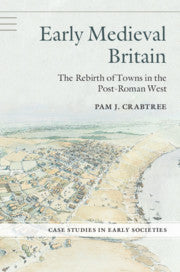Early Medieval Britain : The Rebirth of Towns in the Post-Roman West
- Unit price
- / per
-
Author:Pam Crabtree
-
ISBN:9780521713702
-
Publication Date:July 2018
-
Edition:1
-
Pages:246
-
Binding:Paperback
-
Publisher:Cambridge University Press
-
Country of Publication:United Kingdom


A Back Order button means that we don’t have the book in stock at our store. It may already be on order – or we can order it for you from a publisher or distributor at no additional cost.
As we source items from around the globe, a back-order can take anywhere from 5 days to several weeks to arrive, depending on the title.
To check how long this might take, you’re welcome to contact us and we can provide an ETA or any other information you need. We recommend checking the timeframe before committing to an online order.
Early Medieval Britain : The Rebirth of Towns in the Post-Roman West
- Unit price
- / per
-
Author:Pam Crabtree
-
ISBN:9780521713702
-
Publication Date:July 2018
-
Edition:1
-
Pages:246
-
Binding:Paperback
-
Publisher:Cambridge University Press
-
Country of Publication:United Kingdom
Description
The growth and development of towns and urbanism in the pre-modern world has been of interest to archaeologists since the nineteenth century. Much of the early archaeological research on urban origins focused on regions such as Mesopotamia, Egypt, and Mesoamerica. Intensive archaeological research that has been conducted since the 1960s, much of it as a result of urban redevelopment, has shed new light on the development of towns in Anglo-Saxon England. In this book, Pamela Crabtree uses up-to-date archaeological data to explore urban origins in early medieval Britain. She argues that many Roman towns remained important places on the landscape, despite losing most of their urban character by the fifth century. Beginning with the decline of towns in the fourth and fifth centuries, Crabtree then details the origins and development of towns in Britain from the 7th century through the Norman Conquest in the mid-eleventh century CE. She also sets the development of early medieval urbanism in Britain within a broader, comparative framework.
Adding product to your cart
You may also like
A Back Order button means that we don’t have the book in stock at our store. It may already be on order – or we can order it for you from a publisher or distributor at no additional cost.
As we source items from around the globe, a back-order can take anywhere from 5 days to several weeks to arrive, depending on the title.
To check how long this might take, you’re welcome to contact us and we can provide an ETA or any other information you need. We recommend checking the timeframe before committing to an online order.
You may also like
You may also like
-
The growth and development of towns and urbanism in the pre-modern world has been of interest to archaeologists since the nineteenth century. Much of the early archaeological research on urban origins focused on regions such as Mesopotamia, Egypt, and Mesoamerica. Intensive archaeological research that has been conducted since the 1960s, much of it as a result of urban redevelopment, has shed new light on the development of towns in Anglo-Saxon England. In this book, Pamela Crabtree uses up-to-date archaeological data to explore urban origins in early medieval Britain. She argues that many Roman towns remained important places on the landscape, despite losing most of their urban character by the fifth century. Beginning with the decline of towns in the fourth and fifth centuries, Crabtree then details the origins and development of towns in Britain from the 7th century through the Norman Conquest in the mid-eleventh century CE. She also sets the development of early medieval urbanism in Britain within a broader, comparative framework.
-
-
Author: Pam CrabtreeISBN: 9780521713702Publication Date: July 2018Edition: 1Pages: 246Binding: PaperbackPublisher: Cambridge University PressCountry of Publication: United Kingdom
The growth and development of towns and urbanism in the pre-modern world has been of interest to archaeologists since the nineteenth century. Much of the early archaeological research on urban origins focused on regions such as Mesopotamia, Egypt, and Mesoamerica. Intensive archaeological research that has been conducted since the 1960s, much of it as a result of urban redevelopment, has shed new light on the development of towns in Anglo-Saxon England. In this book, Pamela Crabtree uses up-to-date archaeological data to explore urban origins in early medieval Britain. She argues that many Roman towns remained important places on the landscape, despite losing most of their urban character by the fifth century. Beginning with the decline of towns in the fourth and fifth centuries, Crabtree then details the origins and development of towns in Britain from the 7th century through the Norman Conquest in the mid-eleventh century CE. She also sets the development of early medieval urbanism in Britain within a broader, comparative framework.
-
Author: Pam CrabtreeISBN: 9780521713702Publication Date: July 2018Edition: 1Pages: 246Binding: PaperbackPublisher: Cambridge University PressCountry of Publication: United Kingdom
-



